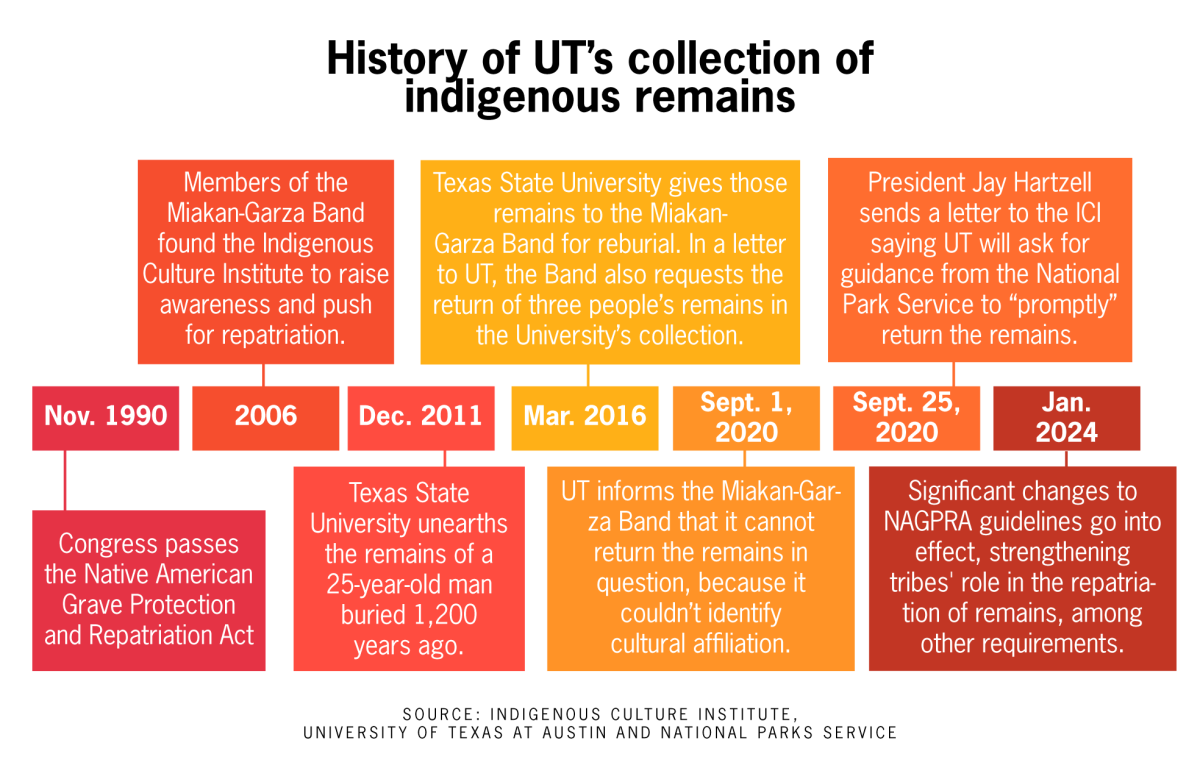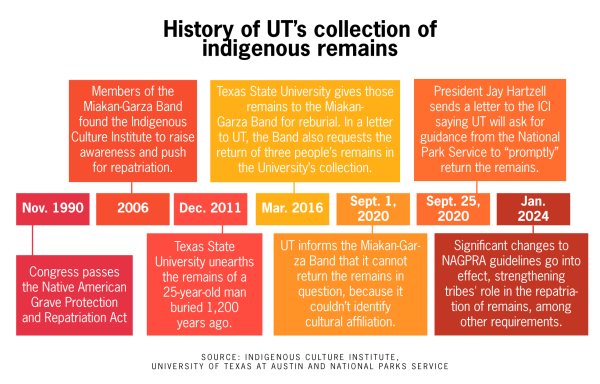President Jay Hartzell promised in 2020 to return Indigenous human remains in the University’s archaeology collection. The Miakan-Garza Band placed a new repatriation request on Jan. 26 after recent changes to the federal guidelines regulating these remains came into effect on Jan. 12.
The tribe made its first repatriation request in 2016. The remains were found in Hays County and “are undisputedly those of prehistoric Native Americans,” according to a University press release.
The Native American Grave Protection and Repatriation Act, or NAGPRA, regulates the Indigenous remains found on public lands and held by museums and universities. The law took effect in 1990, but before that, institutions commonly took human remains from Native American burial sites.
The latest updates to NAGPRA strengthen tribes’ authority and role in the repatriation process and reset “the requirements for cultural affiliation” to match Congress’ original intent, according to the U.S. Department of the Interior.
“I believe that one of the most important things is for the remains to be reburied,” said Mario Garza, the chair of the Indigenous Culture Institute’s board of elders. “When the remains are stolen, two practices happen. It stops the physical process (of the remains’ return to Mother Earth), and it stops the spiritual process.”
The University told the Miakan-Garza it could not return the requested remains because the remains were “culturally unidentifiable” as Miakan-Garza ancestors, according to a September 2020 letter to the tribe.
“The remains that we requested are over 1,000 years old,” Garza said. “None of the federally recognized tribes that have objected to the (request for) remains had been in Texas for over 350 years. … They cannot be their ancestors because they were not here when the individual passed away and was buried.”
Garza’s Institute is a nonprofit representing his tribe and supporting Indigenous issues in Texas. He said objections from federally recognized tribes in Texas complicate repatriation requests.
“(Federally recognized tribes) don’t want a non-federally recognized tribe to have the same benefits of getting remains,” Garza said. “It’s not a legitimate objection to us.”
Kennedy Cortez, co-director of the Native American & Indigenous Collective, said their organization works with Garza’s institute to raise awareness of the remains in UT’s collection, especially by hosting prayer walks.
“Whenever we had our prayer walk last year, 100 people showed up,” Cortez said. “A lot of people were just people who joined in. They were like, ‘I didn’t even know about this. That’s crazy.’… (The remains) were stolen from the earth. They’re literally stolen from their mother.”
The University couldn’t provide an updated statement when asked for comment. According to a document from a University spokesperson, the NAGPRA office told UT in March 2022 to put any repatriation efforts to the Miakan-Garza on hold. UT’s archaeology lab continues to explore options for reburying the remains in its collection.
Despite NAGPRA’s recent changes, Garza said the law has major flaws. He said it leaves room for institutions to find loopholes, and historically, federal law has not benefited Native Americans.
“(Institutions say) they ‘own the remains’,” Garza said. “It’s illegal to own a human being, but they still own the remains of human beings. … It is because we are not considered human beings.”
















